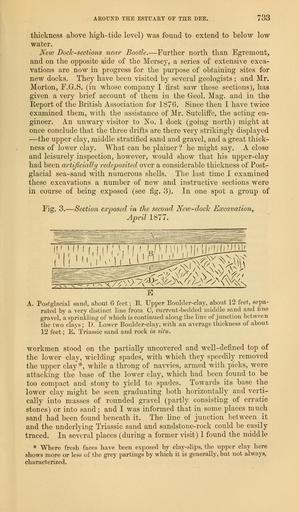MAKE A MEME
View Large Image

| View Original: | The_Quarterly_journal_of_the_Geological_Society_of_London_(12736433975).jpg (1866x3200) | |||
| Download: | Original | Medium | Small | Thumb |
| Courtesy of: | commons.wikimedia.org | More Like This | ||
| Keywords: The Quarterly journal of the Geological Society of London (12736433975).jpg AROUND THE ESTUARY OF THE DEE <br> 733 <br> thickness above high-tide level was found to extend to below low <br> water <br> New Dock-sections near Bootle Further north than Egreraont <br> and on the opposite side of the Mersey a series of extensive exca- <br> vations are now in progress for the purpose of obtaining sites for <br> new docks They have been visited by several geologists ; and Mr <br> Morton P G S in whose company I first saw these sections has <br> given a very brief account of them in the Geol Mag and in the <br> Report of the British Association for 1876 Since then I have twice <br> examined them with the assistance of Mr Sutcliffe the acting en- <br> gineer An unwary visitor to No 1 dock going north might at <br> once conclude that the three drifts are there very strikingly displayed <br> the upper clay middle stratified sand and gravel and a great thick- <br> ness of lower clay What can be plainer he might say A close <br> and leisurely inspection however would show that his upper-clay <br> had been artificially redeposited over a considerable thickness of Post- <br> glacial sea-sand with numerous shells The last time I examined <br> these excavations a number of new and instructive sections were <br> in course of being exposed see fig 3 In one spot a group of <br> Pig 3 Section exposed in the second New-dock Excavation <br> April 1877 <br> A Postglacial sand about 6 feet ; B Upper Boulder-clay about 12 feet sepa- <br> rated by a very distinct line from C current-bedded middle sand and line <br> gravel a sprinkling of which is continued along the line of junction between <br> the two clays ; D Lower Boulder-clay with an average thickness of about <br> 12 feet ; E Triassic sand and rock in situ <br> workmen stood on the partially uncovered and well-defined top of <br> the lower clay wielding spades with which they speedily removed <br> the upper clay while a throng of navvies armed with picks were <br> attacking the base of the lower clay which had been found to be <br> too compact and stony to yield to spades Towards its base the <br> lower clay might be seen graduating both horizontally and verti- <br> cally into masses of rounded gravel partly consisting of erratic <br> stones or into sand ; and I was informed that in some places much <br> sand had been found beneath it The line of junction between it <br> and the underlying Triassic sand and sandstone-rock could be easily <br> traced In several places during a former visit I found the middle <br> Where fresh faces have been exposed by clay-slips the upper clay here <br> shows more or less of the grey partings by which it is generally but not always <br> characterized 35818910 110705 51125 Page 733 Text 33 http //www biodiversitylibrary org/page/35818910 1877 Geological Society of London Biodiversity Heritage Library The Quarterly journal of the Geological Society of London v 33 1877 Geology Periodicals Smithsonian Libraries bhl page 35818910 dc identifier http //biodiversitylibrary org/page/35818910 smithsonian libraries Information field Flickr posted date ISOdate 2014-02-24 Check categories 2015 August 26 CC-BY-2 0 BioDivLibrary https //flickr com/photos/61021753 N02/12736433975 2015-08-26 19 58 33 cc-by-2 0 PD-old-70-1923 The Quarterly journal of the Geological Society of London 1877 Photos uploaded from Flickr by FĂŚ using a script | ||||